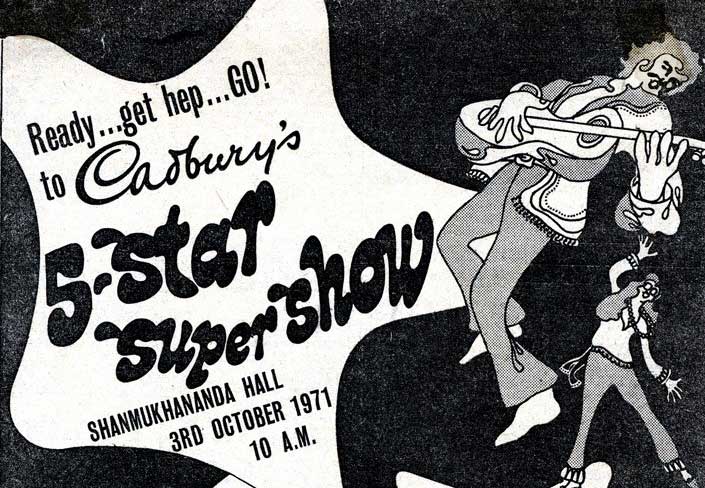Advertising, Rock‘n’roll and jam sessions – Prabhakar Mundkur rewinds back to the 1970s
When one of my friends sent me this 5-star advertisement for a rock show at Shanmukhananda in 1971 I couldn’t help reminiscing. Time was when people in Mumbai were happy to see a rock show early in the morning at 10 am at a traditional auditorium like Shanmukhananda Hall at Sion. One can’t see the auditorium, built to seat over 2700 people, going full house to a Western music pop show today, especially if it was a Sunday morning at 10 am. But times have changed.
The ’60s and ’70s still celebrated Western pop music – although if one were to assume that appreciation of English pop music might be correlated with the familiarity of the English language, people speaking English in the country has only increased over the last few decades but I am not sure rock music is any more popular. So that argument does not hold. I think there is another reason. Hindi pop music was almost entirely Hindi film music in the ’70s and it didn’t have an existence of its own as a genre, except to be associated with Hindi films.
For some reason, English pop music had an active morning audience. I remember in the ’60s, Biddu Appaiah – then known as the Lone Trojan, having broken away from the band called the Trojans – used to take the stage at the Hotel Astoria in Churchgate for a jam session that lasted from 11 am to 1 pm. And a daytime discotheque called Bullock Cart at Rampart Row (Kala Ghoda now) was a full house for their morning jam session, largely occupied by Elphistonians, Xavierites, and students from the other South Mumbai colleges. In many ways, it was still an innocent pastime because people were willing to get high on Coca-Cola and coffee rather than beer and spirits. It meant that young people were coming there primarily for the music and the atmosphere with Coke and coffee providing the social glue for a get-together. And of course, perhaps the sheer thrill of missing a few lectures at college often referred to as ‘bunking’ in those days. I sometimes wonder what it is called now.
The English pop scene was also fuelled by HMV which managed to bring a fair range of English titles into the country. In fact, my first 45 RPM record, ‘I want to hold your hand’ by The Beatles, gifted to me by my mother, was bought at an HMV store on Ranade Road quite close to Dadar Station – and Dadar was by no means a hub for Western pop music and it still isn’t. Later in 1970, Polydor entered the country and that increased our repertoire of Western pop music. Even AIR, that stoic representation of a government radio station, played Western pop music on a program called Saturday Date every Saturday evening. This was the English equivalent of the Binaca Geeta Mala but not half as good and it was not exactly a hit parade.
In many ways, the Cadbury’s Five Star ad above is a social mirror of the times. If we think that attending a western music pop concert on a Sunday morning at 10 am is brave, take a look again at the ad. It was the days when advertising folk were not afraid to think creatively on sales promotions. Wonder if anyone would do that today? Accept product wrappers in lieu of tickets? Our household used Binaca toothpaste only so that I could get those little plastic animals that came with the pack. And we ate A1 bubble gum only because a collection of the stickers inside the pack would entitle us to a cricket scrapbook of famous crickets of that age. Polly Umrigar, Abbas Ali Baig and ML Jaisimha, to name a few. Although advertising was later accused of being very English-biased and talking only to the living rooms of Cumballa Hill and Peddar Road, and the equivalents of Cumballa Hill in other cities, many of the Hindi taglines were born long before that accusation. “Sirf ek Saridon aur Sardard se Aaraam”, “Lifebuoy hai jahaan, tandurusti hai wahaan”, “Lux filmi sitaron ka saundarya sabun” were slogans that we all grew up with.
Hinglish, which is increasingly become the advertising lingua franca of today, was not yet born. People had not started mixing English and Hindi freely even in common-speak. It is not unusual, though. In the Philippines, people speak a mixture of Tagalog and English called Taglish. It only means that people are almost equally familiar with both languages when they do that.
But the late ’60s and the early ’70s were different and this 5-star ad is only a reflection of the times. We were fewer people, life was less busy and we didn’t have the internet or mobile phones to distract us. We still had a hangover from our independence. True we had only two cars, the Fiat and the Ambassador to travel in, and many other restrictions, but I can’t help feeling that in many ways we were a happy lot that looked to our future with anticipation and optimism.









Thank you dear Bal Mundkur for these ‘memorable down-the-memory thoughts’….